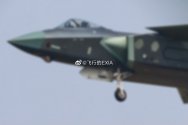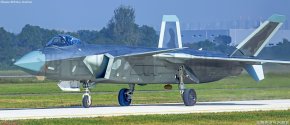I don't think "reducing" of the DSI bump is actually what is happening. I am expecting the second scenario you laid out to be the reality.Well? So did I hit or miss on the inlet modification speculation?
Unfortunately, researching what happened with the DSI inlets, it seems as though the inlets saw significant modification during the WS-10 / AL-31 stage. This was apparently because of difficulties in optimizing the inlets for the WS-10 / AL-31.
This implies that either two things are possible:
One: the Chinese had tremendous difficulty optimizing both for the stealthiness of the J-20 and the full flight envelope of the J-20. The F-35, in contrast, doesn't need its DSI inlet to exceed Mach 1.6, whereas the J-20 is expected to fly at least to Mach 1.8 and perhaps to Mach 2.4. This implies that without substantial inlet modification (and I'm not saying it'll happen, in fact, I'd find it unlikely), the J-20 cannot extract the full potential of the WS-15.
Two: the J-20 inlets were originally designed for the WS-15, and were then back-engineered to support the Al-31 and WS-10. That's where all the trouble came from; if the WS-15 (and this is likely) required more airflow than the Al-31 and WS-10, the Al-31 and WS-10 would then see excess airflow from a fixed (in the sense that there are no moving parts in the DSI) inlet.
I'd prefer the second scenario to be true, but it's questionable as to how effective reducing the DSI bump might be in fulfilling the WS-15's capability. The bump's job is to get boundary layer air to flow away from the inlet. A large bump implies greater effectiveness in doing so. Shrinking the bump to increase airflow would reduce the effectiveness of the DSI at lower speeds.
No one can eyeball the DSI and airflows. Complex computing is needed to visualize how DSI affects the flow of air into the inlets. There was a paper ( from NASA / Airforce) that laid out that DSI was effective up until Mach 2. They didn't say that DSI would be ineffective beyond Mach 2 but that it'd require more complex modeling and other mechanism.
I expect J-20 to have some of the most advanced inlet designs ever put on a production fighter jet.
The article states that J-20 may move away from Research Institute 14s Radar offering to that of Institute 607. Quick search gives that PL-15 radars were developed by Instit 607.
Apprehensive of the veracity of this.


